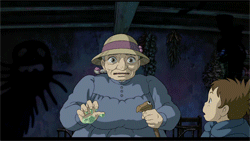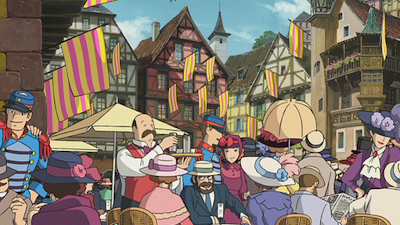Sophie works in a hat-shop in a town called Market Chipping, in the fantasy world of Ingary. She is turned into an old woman by an evil witch until she can break her curse. However, the somewhat unlucky, dull Sophie realizes that she was kind of an old woman in personality already, and it's sort of her natural state. She sets off to find a new place in the world, and stumbles upon the wizard Howl.
The whole idea of an old woman who simultaneously feels young yet old is really epitomized here: she's literally both at once. Much like Clarissa, she spends a lot of time thinking about her "past" and when she was younger (technically last week, but) and thinks she isn't beautiful at all. Sophie really just seems very Clarissa-like in her manner, always getting lost in thoughts and not thinking of herself as important at all. Also like Clarissa, she is strong-willed, kind, and considerate, if a little impulsive.
Some of the opening scenes in Dalloway really remind me of the images in Howl's...
Mostly the images of a prim, straight-backed woman taking a walk in a crowded city. Miyazaki's admittedly more steampunk machines and automobiles still show lot of similarities to Woolf's realism.
Here we have Sophie's sister in the story, Lettie. She reminds me a lot of Lucrezia as she takes care of Sophie, who, as we see, is rather absent-minded and apathetic, much like Septimus is, outwardly.
Lucrezia and Clarissa don't know each other in Mrs. Dalloway, but if they did, I feel like it would be a lot like that right-hand gif. That interaction definitely happens between Rezia and Septimus several times throughout the book.
Now for the big similarity I see- setting. I've alluded to this a few times, but the time and place setting of both stories are similar. The land of Ingary resembles a steampunky, fantasy early 20th century London.We first meet Sophie in Market Chipping, a smaller town full of hat shops, flower shops, and people who buy frivolous things from them. This world differs from June 1923 in that Ingary is not a post-war setting; instead it is currently at war with Strangia and High Norland, neighboring countries. Its capital is Kingsbury, and Sophie spends some time there as well. Kingsbury especially reminds me of Clarissa's London, with huge towers and orderly hustle and bustle.


I love the visuals of people taking strolls past this big statue: it really evokes those images that Peter, Rezia, and Septimus see in Regent's Park (in p. 69-71) of all these calm, dignified people going about their day.
(There's also a port scene which I vaguely remember, maybe from at Bourton? I got a strong mental image of this shot from Howl's Moving Castle:
I wonder if Miyazaki or his art staff had read Dalloway, or if 1920s England was such an iconic era that it's so instantly recognizable.











